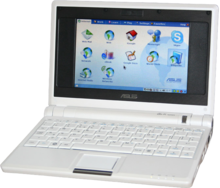
Back Asus Eee PC AF Asus Eee PC Catalan ASUS Eee PC Czech Asus Eee PC Danish Asus Eee PC German ASUS Eee PC EO ASUS Eee PC Spanish Asus Eee PC ET Asus Eee PC EU ایسوس ئیئیئی پیسی FA
 | |
 | |
| Developer | Asus |
|---|---|
| Type | Netbook |
| Operating system | Linux (Xandros) Windows (XP, 7, 8.1) |
| CPU | Intel (Celeron, Atom) AMD (AMD Fusion) |
The ASUS Eee PC is a netbook computer line from Asus, and a part of the ASUS Eee product family. At the time of its introduction in late 2007, it was noted for its combination of a lightweight, Linux-based operating system, solid-state drive (SSD), and relatively low cost. Newer models added the options of Microsoft Windows operating system and rotating media hard disk drives (HDD), and initially retailed for up to 500 euros.[1]
The first Eee PC was a milestone in the personal computer business,[2] launching the netbook category of small, low-cost laptops in the West (in Japan, subnotebooks had long been a staple in computing). According to Asus, the name Eee derives from "the three Es", an abbreviation of its advertising slogan for the device: "Easy to learn, Easy to work, Easy to play".[3]
In January 2013, ASUS officially ended production of their Eee PC series, citing declining sales due to consumers favoring tablets and Ultrabooks over netbooks.[4][5] However, they subsequently restarted the line with the release of the EeeBook series in 2015.[6]
- ^ Cite error: The named reference
notebookcheckwas invoked but never defined (see the help page). - ^ Michael Copeland (14 October 2008). "Disruptors: The 'netbook' revolution". Fortune. Retrieved 1 November 2017.
- ^ Cite error: The named reference
Auto5F-1was invoked but never defined (see the help page). - ^ Spurbeck, Jared (3 January 2013). "Acer and Asus to Stop Making Netbooks". Yahoo!. Archived from the original on 7 January 2013. Retrieved 13 January 2013.
- ^ Condliffe, Jeff (2 January 2013). "Asus and Acer: The Netbook Is Dead". Gizmodo. Retrieved 13 February 2013.
- ^ Krawczyk, Konrad (3 September 2014). "Asus' goofiest name returns in the EeeBook X205, a $200 Windows 8.1 notebook". Retrieved 27 December 2014.